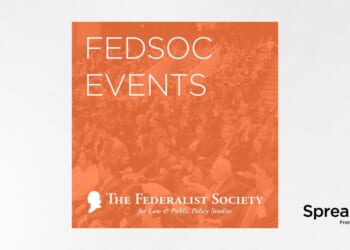Politicians always lie, and when those politicians are Democrats, they typically have the media on their side. But rarely have the Democrats had so much success in roping in the news media to misrepresent the facts so blatantly as they did in President Donald Trump’s first term regarding the Tax Cuts and Jobs Act.
Future students of media and politics ought to study the coverage of TCJA as an extreme case in how partisans, acting together with a friendly media, can cause huge swaths of the public to believe verifiably false things.
TCJA cut taxes for almost all Americans, certainly for all middle-class workers who pay taxes. Yet many people, and a vast majority of liberal Americans, those who mistakenly put their trust in the liberal media, believed that the law increased their taxes.
Now that many of TCJA’s policies are set to expire this year and their renewal is up for debate, it’s worth recalling this unseemly episode.
What TCJA did
The Tax Cuts and Jobs Act was a 185-page bill with hundreds of provisions, some of which offset one another. That made it easy for the average American to get confused, especially by partisans and reporters who weren’t really trying to clarify things.
Here are the major provisions of the law:
To start at the bottom of the income ladder, the TCJA increased the “zero-percent” tax bracket by nearly doubling the standard deduction from $6,350 to $12,000 while eliminating the personal exemption of $4,050. That meant the average single, unmarried taxpayer received their first $12,000 tax-free compared to $10,400 before the law.
The bill also doubled the Child Tax Credit to $2,000.
Most individual tax rates were also lowered. The 15% tax rate (on income from about $10,000 to about $40,000 for singles) was reduced to 12%. The 25%, 28%, 33%, and 39.6% rates were also cut, but by smaller ratios.
That is, every change for middle-class earners was a tax cut.
For the upper-middle class, the package was a bit more mixed. On the tax-cut side, the Child Tax Credit didn’t begin phasing out until $400,000 per couple, compared to $110,000 beforehand. Likewise, the Alternative Minimum Tax (a policy that was supposed to deny excessive deductions to the very wealthy) no longer applied to those earning less than a million dollars.
But there were some upper-middle-class tax hikes, too. The deduction for state and local taxes, previously unlimited, was capped at $10,000. The deduction for mortgage interest, previously unlimited, was capped at the interest on the first $750,000 of a mortgage. These tax hikes basically only affected higher earners, especially because the nearly-doubled standard deduction meant that only the wealthy itemized their deductions.
Yes, some middle-class earners with expensive houses in high-tax blue states took a lump from the SALT cap, but most of them saw an offsetting cut from the rate cuts, the higher CTC, and the AMT fix.
The law also cut corporate tax rates. It wasn’t an aggressive tax reform because it didn’t eliminate corporate tax credits and special-interest exemptions, but a law that lowers rates, expands the standard deduction, and doesn’t add new carveouts is at least a slight tax reform.
Who was affected and how?
So how did all of these changes interact? Different households in different situations were affected differently of course, but overwhelmingly everyone got a tax cut, especially the middle class and below.
Under TCJA, the lowest quintile’s effective tax rate was reduced to 0%. This was a historically progressive tax change. Throughout most of the 1980s, the lowest quintile paid an effective rate of about 10%. It was lower after the Bush tax cuts but still significantly above zero. TCJA made it clear that the lowest 20% of earners would not pay federal income taxes.
So that’s a 100% tax cut for anyone in the lowest quintile who was still paying federal income tax. You can’t do any more for the poor with a tax law. A family of four earning $60,000, for instance, got a 100% income-tax cut.
Each of the four higher income quintiles, taken as a whole, also saw a tax cut, according to the Tax Foundation’s analysis.
The median household income in 2018 for a married couple with children was about $100,000. TCJA cut that family’s income taxes from about $7,700 to about $4,700 a year — almost a 40% tax cut for a middle-class family.
Again, that doesn’t mean every taxpayer got a tax break. Some higher earners in high-tax states saw a tax hike.
For instance, if you claimed a very large SALT deduction, meaning you had a very high income or owned a very expensive, highly taxed home, the $10,000 cap might hit you very hard. Still, the rate reductions and the adjustments to the AMT and CTC would offset that.
The Tax Policy Center, a left-leaning organization, estimated that two-thirds of Americans got a tax cut. (It wasn’t a higher percentage only because so many lower-income Americans already paid zero in income taxes.) Only 6% faced a tax hike from the bill. The Institute on Taxation and Economic Policy, another liberal group, found that for every income quintile in every state, the average taxpayer got a tax cut.
“The vast majority of people did get a tax cut,” an analyst at H&R Block’s Tax Institute told the New York Times in 2019.
The true argument liberals could make was that high earners generally got a larger tax cut, dollar-wise, compared to lower earners. That’s to be expected because the U.S. has a very progressive tax system, and so the wealthy pay taxes at much higher rates. If the wealthy are paying most of the taxes, the wealthy will get most of the benefit from across-the-board reduction in tax rates.
An example: That 40% tax cut for the median family of four was worth $3,000, while empty-nesters earning $400,000 could very likely see their taxes reduced from $90,000 to $82,000 — less than a 10% tax cut, but more than twice as much dollar-wise as the middle-class workers.
Nevertheless, TCJA actually made the federal income tax code more progressive by shifting a greater portion of income taxes onto the backs of the wealthy.
In 2021, the top 5% of earners made 42% of all income, and paid 66% of all income taxes.
The media fooled people
Even though this law cut taxes for a vast majority of Americans, and for basically every single middle-class American, nobody is surprised that Democrats tried to convince the average American this bill would raise their taxes and that only the rich would get a tax cut.
What was surprising was how the news media engaged in the same misinformation campaign.
“It does not help individuals who are below $100,000,” reporter Ron Insana said on an MSNBC segment where I was the conservative commentator and Insana was supposed to be the straight news reporter. “In fact, it probably doesn’t help individuals who are below $200,000, given the analysis we’ve seen thus far. It is not a middle-class tax cut.”
This was typical of the media coverage of the law. And it worked.
In late 2017, the Washington Examiner polled American adults and found that one-third believed that the bill raised taxes on middle-class families. Only 28% knew that the bill cut taxes on most middle-class families.
Democrats were much more likely to be wrong: 51% said 2018 taxes will be higher for most middle-class families. In other words, the more you trusted the major media, the more likely you were to be wrong.
Things got so bad that the New York Times in 2019 had to run a piece headlined “Face It: You (Probably) Got a Tax Cut.”
Even after the media admitted that it was a tax cut, Democrats kept repeating their lies. Joe Biden, in his 2022 State of the Union Address — a speech carefully written and rewritten and checked, made this dishonest statement about TCJA: “Unlike the $2 trillion tax cut passed in the previous administration that benefited the top 1% of Americans, the American Rescue Plan helped working people — and left no one behind.”
The direct and undeniable implication was that TCJA didn’t help working people and benefited only the top 1%.
HOUSE BUDGET HAWKS SHOULD CONTINUE FIGHTING FOR SPENDING CUTS
Many of the major news outlets that fact-checked Biden’s speech and the Republican response failed to check Biden’s false assertion. CNN, Washington Post, and the AP, to name just three, all let Biden’s malarkey go unchecked. FactCheck.org, to its credit, noted, “Biden misleadingly said the tax cuts enacted in 2017 ‘benefited the top 1% of Americans.’ Americans in every income category got tax cuts.”
These days, Democrats talk about “repealing Trump’s tax law.” They won’t, because that would mean passing a massive middle-class tax increase.The history of TCJA ought to inform debate over renewing the law’s provisions. But also, it ought to make the average American ask, what is the news media lying about today?















